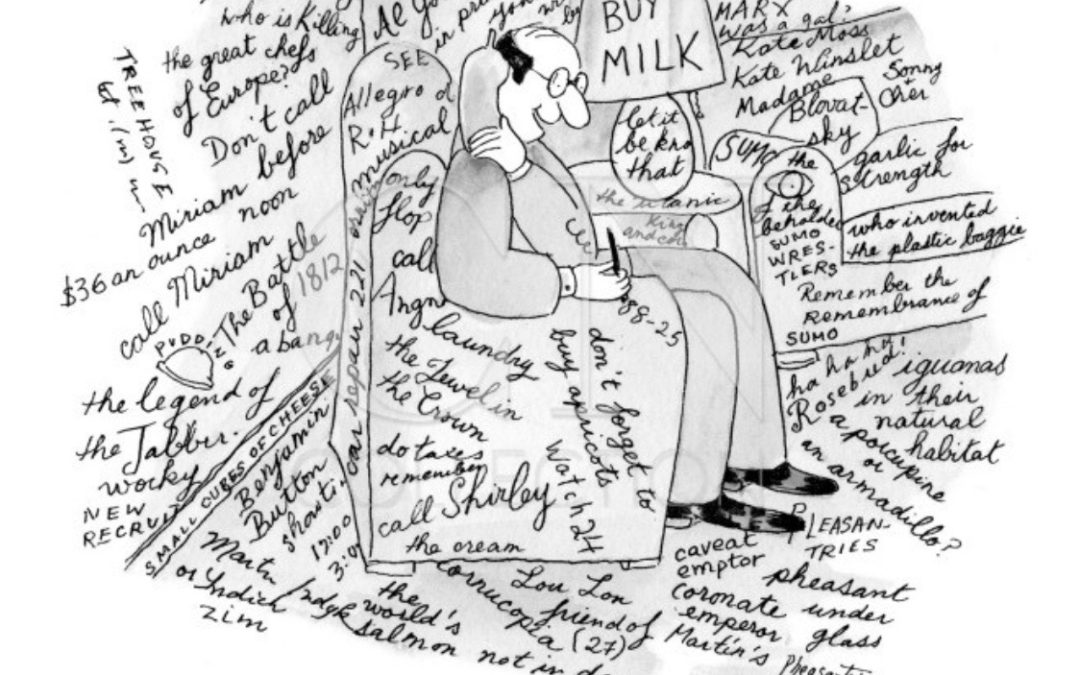
by Sandra Gulland | Jan 29, 2017 | Adventures of a Writing Life, Publication, Resources for Writers, The Writing Process |
Figuring out a novel’s “elevator pitch” — the summation of a story in a sentence or two — is invariably difficult for novelists, at least it is for me. My mind does not lend itself to reductions. I’m more of the expanding type. (Not an asset.) These 4 formulas — which I’ve gathered from hither and yon in decades of reading books on writing — are helpful in getting at the core of that unwieldy beast: a novel.
The 1-sentence formula
When _____ [OPENING CONFLICT]
happens to _____ [CHARACTER],
he/she has to _____ [OVERCOME CONFLICT]
in order to _____ [COMPLETE QUEST].
As applied to my next novel, The Game of Hope, I came up with:
Haunted by dreams of her dead father, a 15-year-old girl goes on a quest to find out if she was the cause of his death.
This is a tidy summary, but as with most one-sentence summaries, this doesn’t actually fit what actually happens in the novel.
The 3-sentence formula
_____ is about _____, who wants to _____.
The only problem is that _____.
As a result, he/she _____.
Yet, ultimately, he/she succeeds because _____.
One problem with this summary is that it gives too much away.
The 3-part book formula
1. The genre (i.e. “mystery novel”);
2. Parameters: what happens and what the reader getting into (“Seattle”, “a detective” “a dead boyfriend”);
3. Something left to the imagination (a dead body, a framed main character).
The Game of Hope is historical fiction for Young Adults. It’s about Josephine Bonaparte’s daughter Hortense, who hates her stepfather Napoleon and idolizes her dead father … until she finds out some unpleasant truths.
This is better, perhaps. It’s important to leave something unsaid, to tempt the reader.
The 5-part story formula
1. Character
2. Situation (What trouble that forces the character to act?)
3. Objective (The character’s goal.)
4. Opponent
5. Disaster (The awful thing that could happen.)
Make each of these elements specific.
Put them together to form two sentences.
Sentence 1: A statement that establishes character, situation, and objective.
Sentence 2: A statement—or question—that pinpoints the opponent and potential disaster.
Haunted by nightmares of her dead father, 15-year-old Hortense goes on a quest to find out if the father she idolizes is trying to tell her something. Was it her fault that he was executed? What she finds out is not at all what she expected, and more of this world than the next.
I think this is a better summary — but I don’t think I’ve nailed down the 5 elements yet.
And more …
I recently read Gotta Read It!: Five Simple Steps to a Fiction Pitch that Sells by Libbie Hawker (a book I recommend). She writes:
To construct a skeleton for your pitch, answer the following five questions as simply and blandly as you can: Who is your main character? What does she want? What stands in her way? What will she do, or what must she do, to achieve her goal? What is at stake if she fails?
Hawker’s book is about how to write a longer summation of your novel — one that might be used to send to a prospective agent, or be put on the jacket of your novel, on Amazon or in the publisher’s catalogue, for example. One begins with this short summary, the distillation of the novel, and then fleshes out “the skeleton” to represent the tone and subject of the novel truly.
The Game of Hope is soon to go into production, so it’s time for me to begin thinking how to frame the story, pitch it to readers. It’s never easy, but these guidelines help.
SaveSave
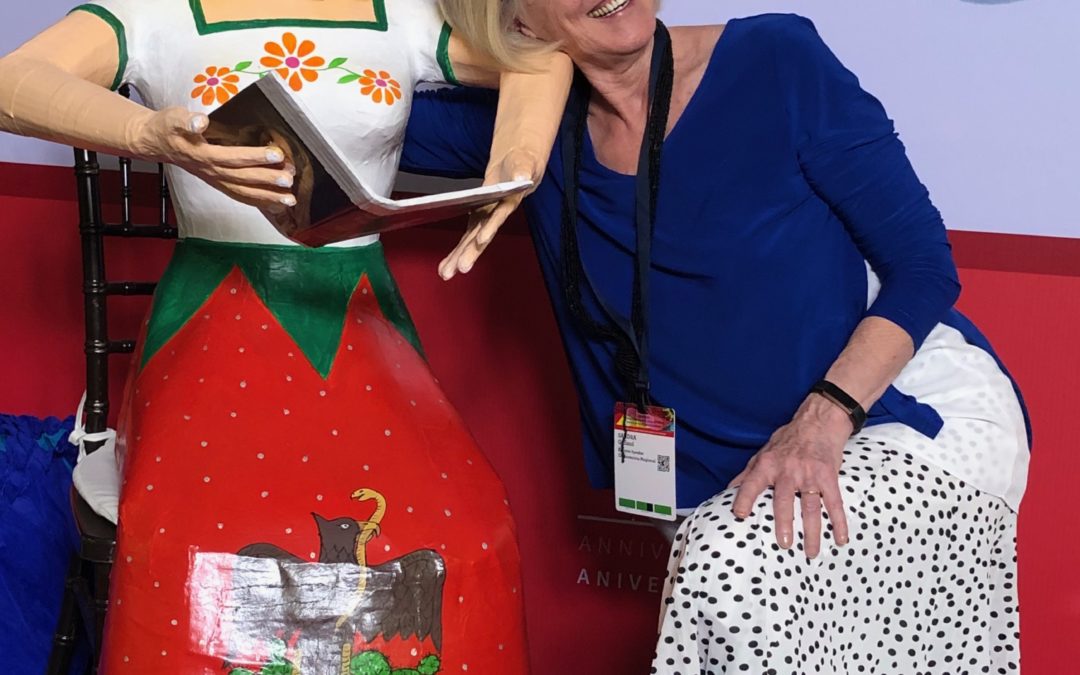
by Sandra Gulland | Jun 30, 2015 | Adventures of a Writing Life |
In one month I’m to give a reading not far from where I live. It’s high time I started preparing. (Did you know that presenters of TED talks prepare for months? For fascinating links on this process: go here.)
An author reading is not a reading: it’s a talk
The first thing to understand about preparing to give a reading is that it should not really be a “reading” at all — it’s best if it’s an engaging talk, with a mere sprinkling of readings thrown in.
Who is in the audience?
Every author needs to be prepared for an audience of 1 or 100. For my event coming up, it’s likely to be a good-sized crowd. A number of those attending will be friends and family.
This raises the bar!
I have given a number of talks in my area over the decades. I want it to go over well, and I don’t want to repeat myself.
That bar just went up several more notches.
Review print-outs and videos of past author readings
I’ve begun preparing for the talk coming up by digging out my earlier speeches. In the process, I discovered a video of a talk I gave about seven years ago. I had just finished a US tour for Mistress of the Sun, and speaking before a crowd daily for weeks on end was great preparation. I also had the advantage of a friend/filmmaker to film this talk, so the recording is without the usual wiggles and jumps.
Decide what to wear
This is a surprisingly important question. At an author reading, people sit and look at you for an hour. I’ve learned not to wear jewelry that can jangle against a mike. Bright is good. Comfortable is great. Fashionable and hip would be nice. Presenting in costume is guaranteed to be a hit.
I often present in historical dress. It’s fun, and everyone enjoys it. However, for me, a question is: Should I wear the same costume I wore the last time I gave a reading at this festival? I think not. A number of people attending will have been at the last one.
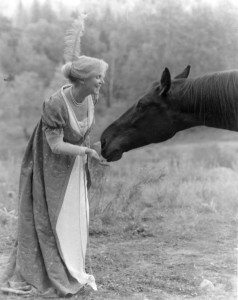
{The photo of me and my horse was taken by Barney McCaffrey.}
I could wear my Josephine gown, which would be relevant to the novel I’m writing now … but not relevant to The Shadow Queen, my latest publication.
Alas, I’m afraid that I should go simply as myself. To tell the truth, I find this somewhat intimidating. It means that content of the talk itself is going to have to be excellent.
Next up: On writing and outlining an author talk. Visuals or not? Give-aways or not?
I’ll keep you posted.
Links of interest
Weekly I’ve started posting links to things I find of interest on the Net. I’m calling it a Sundae of Sundries (posted every Sunday, of course). Let me know if there are any articles or blogs you’d like to share.
The Facts of Life (& Other Mysteries)
I continue to work and rework the WIP, which I’m now calling The Facts of Life (& Other Mysteries). What do you think of that title?
Revision is such slow work. One must be patient and have faith in the process. The work invariably feels broken at this stage.
I was heartened to see this page of revision made by Orwell for 1984. My own pages look similar.
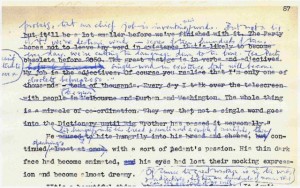

by Sandra Gulland | Apr 16, 2015 | Adventures of a Writing Life, Resources for Writers, The Writing Process |
At nine this morning there were 13 people in our house, all talking and going about their business. Many of them had showed up at 8:00. We’re having our house painted, some people were here to scope out photo ops (for what, I don’t know), etc. etc. etc.
It’s a chaotic time of year at the best of times. In two weeks we fly back to Canada. Wrapping up a half-year of work and books and notes and stuff always sends me into a spin, but this year it is intensified because we’ve put our house in San Miguel de Allende, Mexico, up for sale, and are building (and designing) a new one here.
Upheaval!
We have been living half-the-year in Mexico for close to twenty years. Because we will be moving, I’ve been pruning my selves and closets. Long overdue, true, but it’s harder for a writer of historical fiction, I suspect, and especially for one (like me) who doesn’t throw anything away. In the last week I’ve sent off five or six big boxes of give-aways of out-dated computer equipment and books I know I will no longer need.
Worse, I have stacks of edited drafts in my office lock-up.
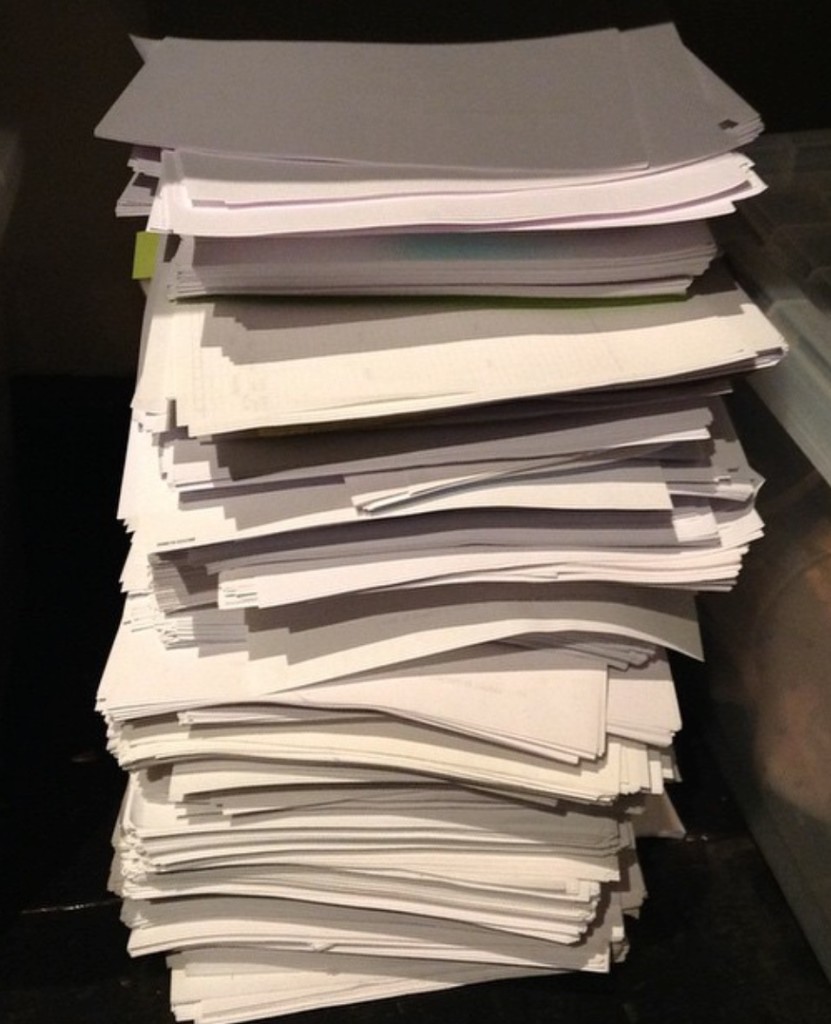
As in stacks!
Clutter—or literary archives?
Long ago, in a Margaret Atwood workshop, she told the class: “Don’t throw anything away.” (Dangerous words to tell a hoarder.)
I recently told my good friend Merilyn Simonds that I was going to have to throw out the papers filling up my lock-up and she exclaimed, “Don’t!”
Both Merilyn Simonds and Margaret Atwood are archived. Their papers are picked up every year—sweet!—to be put into their literary archives, lodged in a university library. This is something I have long intended to look into (more on this later, I promise), but for the time being—and perhaps forever—my “literary archives” are basically clutter in the basement of our house in Canada and in my storage lock-up in Mexico.
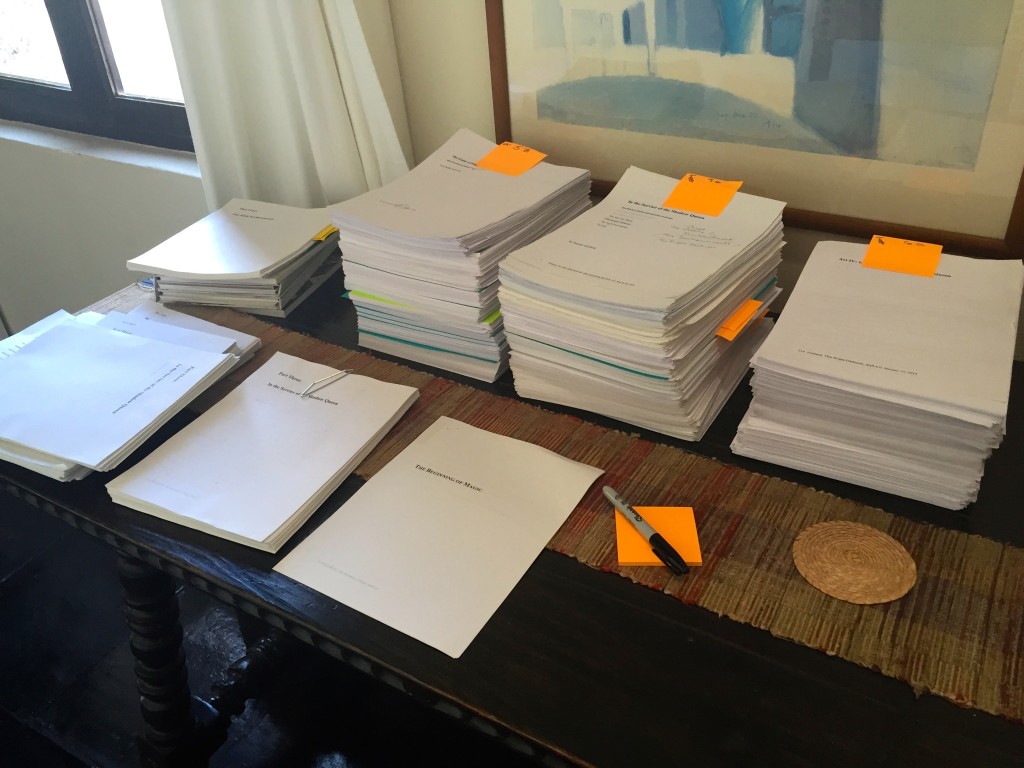
Sorting and labelling the papers this morning so that at least they can be easily moved to the next lock-up made three things clear about my writing process.
- One: I write lots of drafts.
- Two: I print out lots of drafts.
- Three: I am messy as all get out. (Don’t you love that old expression?)
Do I even want this known? A good question!
Two things I learned, and which I recommend for your literary archives
1) I am very glad that I include the draft number in the footer of each draft. Here is the format I am using now:
Gulland, The Game of Hope, draft 5.5, started April 1, 2015
2) I regret that I haven’t dated the editorial notes I receive, or noted who wrote them. (Of course I thought it was obvious at the time.)
I was amused to see this title page on draft 9.6 of what is now The Shadow Queen:
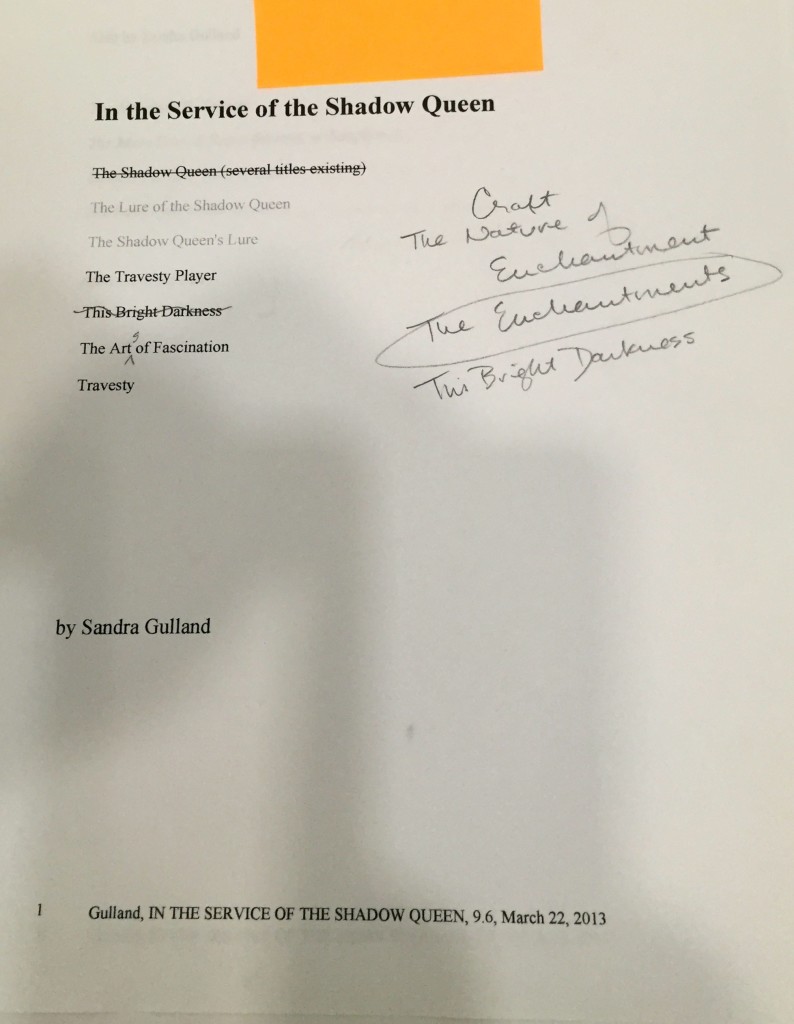
The title of that novel went through so many evolutions!
Figuring out how to begin writing again
Mixed in with all this is the ongoing frustration of trying to figure out how to proceed with my ever-so-challenging draft 5.4 (i.e. the 4th draft of the 5th draft) of The Game of Hope.
There are many new chapters, new scenes required—intimidating!—and I decided that since life is chaotic, the solution might be to tackle writing in a chaotic way: I will simply write snippets of dialogue and scenes as they come to me, and piece them together later.
Writing new material is always a bit like inching into a pool of very cold water, and because there is so very much to do in this coming-and-going transition period, I have set myself a simple goal: 100 words a day. Once that’s going, I will inch it up.
Update: 316 words today! This is what happens when you set a 100-word-a-day goal. :-)

by Sandra Gulland | Feb 12, 2015 | Adventures of a Writing Life, Resources for Writers, The Writing Process |
It’s a busy week in San Miguel de Allende: the Writers’ Conference is on and there are many writers in town.
Yesterday I heard Tracy Chevalier‘s keynote address on the importance of history (wonderful), and tonight my husband and I are going to hear Scott Turow. Tomorrow, Gloria Steinem, and Saturday, Jane Urquhart.
I likely would not have written the Josephine B. Trilogy had it not been for the advice of Jane Urquhart, who was writer-in-residence at the Univ. of Ottawa when I was trying to figure out what to do with my very messy draft of a contemporary-mystery-comedy. I’m especially excited to see her.
As busy as all this sounds, I’m taking it relatively easy this year, because I’m working on draft 5 of The Game of Hope.
Something I wish I had the patience to do:
“I have done the second draft of all of my novels in longhand so that I slow down and think about what I’m doing more. That has been extremely helpful.” — Russell Rowland in a 5 on interview. He also has some very interesting things to say about self-publishing.
Interestingly, Tracy Chevalier writes in longhand, and then types the day’s work into the computer at the end of the day.
An excellent overview: The 8 Habits of Highly Successful Young-Adult Fiction Authors
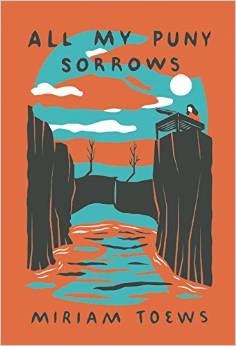
What I’m reading now: All My Puny Sorrows, by Miriam Toews. Wonderful!
The photo of San Miguel de Allende at the top is by photographer and friend Leah Feldon.

by Sandra Gulland | Jan 30, 2015 | Adventures of a Writing Life |
Remember the first photos of Earth from space? It created a sea-change in our perspective.
As a child, my father found it amusing how disturbed I was by the idea of infinity. I am challenged anew, and in a rather marvellous way, seeing this amazing NASA video.
The word “perspective” has many meanings. It is an old word, dating from 1300s.
1387: Aristotle..made..problemys of perspective [L. perspectiva problemata] and of methaphesik.
a1661 W. Brereton (1844) 60 Wm. Daviseon offered to furnish me with a couple of these perspectives, which shew the new-found motion of the stars about Jupiter.
1692 tr. C. de Saint-Évremond 280 By the means of great Perspectives, which Invention becomes more perfect every Day, they discover new Planets.
1605 Bacon ii. sig. Hh3, We haue endeauoured in these our Partitions to observe a kind of perspectiue, that one part may cast light vpon another.
It’s this last, the sense of “putting things in perspective,” that this NASA video vividly evokes for me. What do our own small lives matter, after all?
I am consoled by William Blake’s lines from Auguries of Innocence:
To see a World in a Grain of Sand
And a Heaven in a Wild Flower,
Hold Infinity in the palm of your hand
And Eternity in an hour.
I begin each day working to create a world on the page. Every age has its moment of wonder, of awe, of expanded perspective. I’m wondering what that moment was for Hortense at the end of the 18th century.
Worth reading …
The Incident of the Fly Swatter, a blog post on Wonders & Marvels, on some historical perspective on the relationship between France and the Muslim world.












